A blog post that focuses mainly on the food and wines my cousin Luke and I had on our mid-December trip to Budapest, Hungary!
I had been to Budapest twice before way back in 2007 and 2008 before you could get a direct flight there from the north-west of England (I’d connected in Prague and Zurich). I had enjoyed the cultural experience of seeing where my heritage came from but I must admit that I did not find the city easily navigable and it was hard to seek out places and activities without Smart Phones with Google Maps and taxi apps (Budapest now uses Bolt rather than Uber as of 2023).
In June this year, our grandad János passed away just before he turned 93 after a long and illustrious life. He was born in 1930 and raised on Csepel Sziget (Island), an area just north of Budapest but still within the capital city borders, neither on Buda nor Pest.
His passing this summer reignited curiosity and a thirst for knowledge in us all so it made total sense for my cousin Luke and I to head over at the start of our Christmas holidays. But would it be too cold? This was a main concern. Would it look pretty when the trees are bare? Would there be enough to see to do?
We needn’t have worried, Budapest in the days before Christmas (17th-21st December) was a magical delight and I would heartily recommend anyone interested in visiting Budapest to give it a whirl during the festive season. The temperatures were similar to the UK and actually felt milder for the majority of the time with low winter sun and an absence of wind or rain.

We arrived late on the 17th December after a punctual and smooth flight with WizzAir from Liverpool airport then headed to bed to reenergise for the next day.
Eager to taste some heart-warming Hungarian food on a cold, bright day, we walked a few minutes from our hotel in District 5 towards a restaurant called Paprika Jansci Étterem on Ráday Utca. The restaurant (étterem) is named after Hungary’s beloved dried pepper- paprika. Our uncle was known as Jancsi so it felt somewhat familiar to enter.
Strings of dried garlic and paprika chillies adorned the fireplace and traditional red-and-white checked tablecloths gave a sense of homeliness and the rich smells upon entering were mouth watering. It was 12pm and quiet with only one other table occupied, except for the occasional comical, shrill ring of the telephone. This was what we needed while still tired after finishing work for Christmas then travelling over.

Luke and I both opted for a pörkölt (stew), a dish made often by Luke’s mum. Chicken in a rich paprika sauce topped with chives and sour cream with a generous serving of galuska (dumpling noodles known as spätzle in German-speaking regions of Europe) was perfect for a chilly early afternoon which we consumed with two double espresso which was like an injection of rocket fuel to the system!
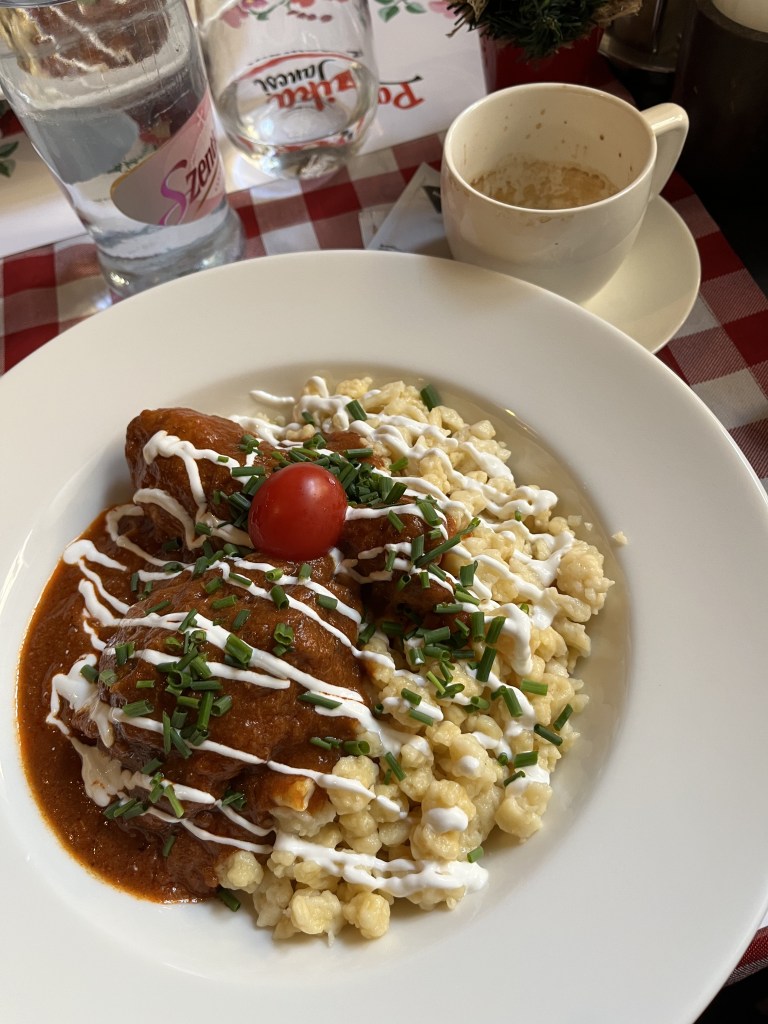
Refuelled and intensely caffeinated, we headed back into the sunny December streets and walked through the Jewish district, glimpsing the ornate turrets of the Dohány Street Synagogue, the largest synagogue in Europe with architecture largely modelled on La Alhambra in Granada, Spain.

We also took the opportunity to photograph a street with the name ‘Károly’ in after our mums’ full brother’s name (which would be Charles in English).
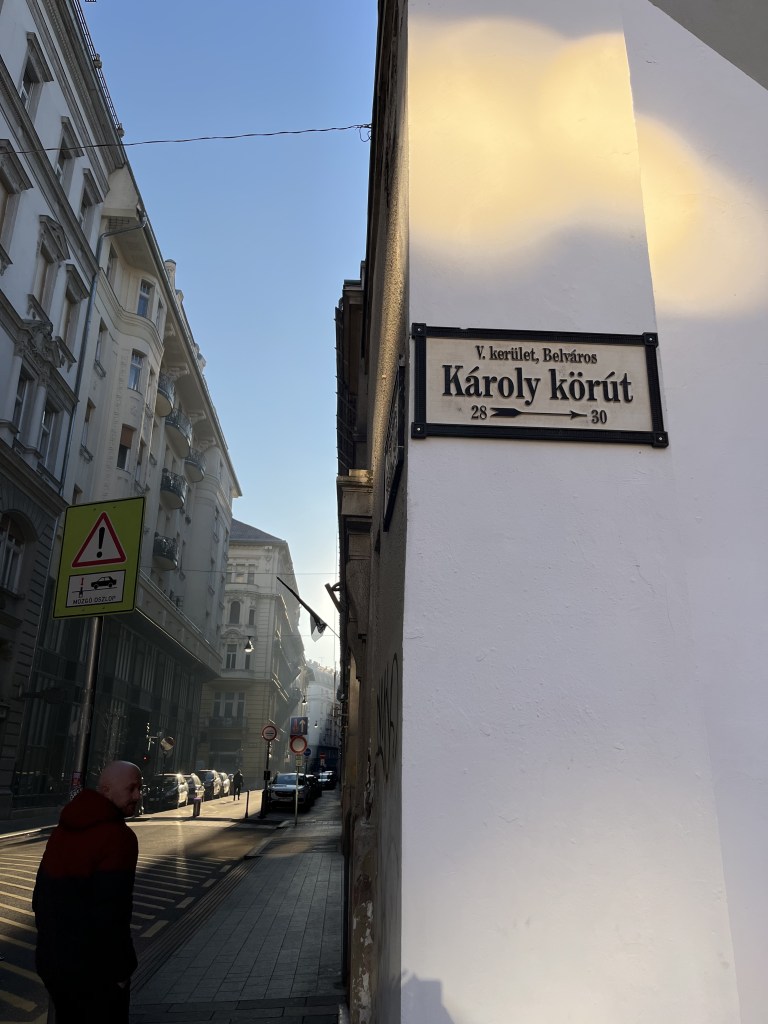
Walking through District 7 back towards our hotel, we saw a gallery of bars attached to a beautiful hotel called Párisi so called in to see what was on offer.
It was a stunning art deco golden hall filled with champagne and coffee bars set in a serene and classy ambience which could not be bypassed so we each ordered a mulled wine (called forralt bor in Hungary) which, with no hyperbole, was the best mulled wine either of us had ever tried with a richness almost like a hot chocolate you rarely find in batch-made mulled wine.


Budapest has eight bridges across its section of the Danube river and we just so happened to end up strolling across the white Elizabeth Bridge (Erzsébet híd) so named after Queen Elizabeth II just as my mum was (my grandad received his dual citizenship with British in the year my mum was born, hence the tribute).
The pre-Solstice sky was clear baby blue as boats glided peacefully across one side of the city to the other. Proud Hungarian and Turkish flags (a nod to Hungary’s Ottoman past) rippled in the breeze lining the view of the architecture on Buda such as Buda Castle and the Fisherman’s Bastion, and the metropolis of Pest.


In the early evening, we stumbled across Budapest’s Christmas market in Szent István tér (St. Stephen’s Square) which is compact but calm. You can peruse the stalls selling crafts at leisure without bustling crowds so found in other cities. This square is also home to the Szent István Bazilika, the Roman Catholic cathedral of Budapest.
There was an advent service taking place when we were there so we did not enter but we stood and watched an illuminated count down to the hour (6pm) which culminated in a cute light show cast against its façade that depicted religious figures and the Nativity.
Luke had discovered a wine bar in the Jewish district called Doblo and we had a table booked for 7pm. The waitress knew about all the wines on the list, all Hungarian, and recommended a red from Villány in the south of Hungary which was a delight. We also ordered a Hungarian charcuterie board of local cheeses and meats which obviously went down well with the wine!
The dim lighting and almost gothic/gypsyesque decor made for a chilled vibe that was so modern compared to my last stay in Budapest in 2008 when I could not even find a bar to get a single cheap drink in and ended up inadvertently wandering into a pole dancer’s club before heading right back out! These bars reminded us of our trip earlier this year to Warsaw which are trendier and of far better quality than most bars we get back in the UK. It wasn’t cheap, but you get what you pay for.
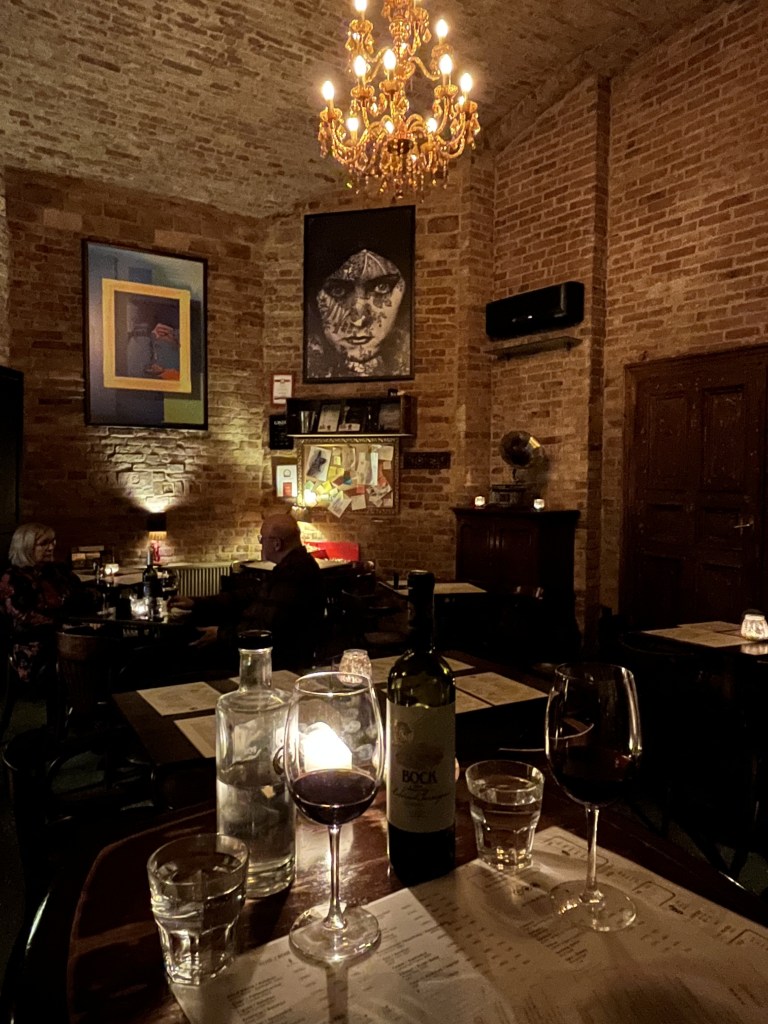
After Doblo, we wandered back through the streets and stumbled across one of Budapest’s famous ruin bars. Ruin bars are a bit like dive bars in that they have a sort of underground, cool vibe to them but they are set in repurposed old buildings and have various sections to them to suit whatever flavour of night out you are seeking.
The one we fell into was arguably the most famous, Szimpla Kert (Simple Garden) which is an old converted stove factory which now scales various floors and has everything from a beer garden to a shisha bar, rave room, outdoor cinema, shops and more.
I was a bit stuck for choice for a drink as I only really drink wine nowadays which they didn’t have so I had a shot of palinka which is a clear Hungarian cherry brandy but it really wasn’t drinkable to my unaccustomed British palate, tasting to me like witch hazel (sorry!).
Expect quirky furnishings found in jumble sales, old fairgrounds, demolished schools and more at this tourist-friendly yet still very much locally-frequented, massive pub in the heart of the Jewish district.

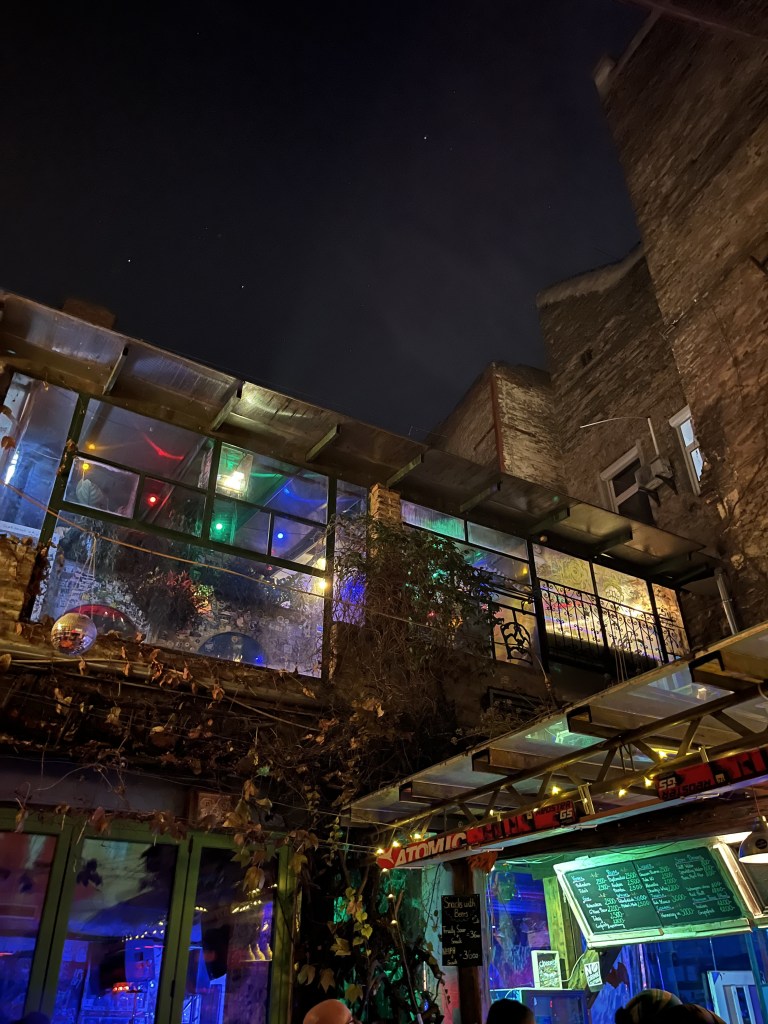

The next day, we walked back into the Jewish quarter as Luke had found somewhere whilst zooming in on Google Maps called Gettó Gulyás (Ghetto Goulash) which promised the best goulash in Budapest- but you quickly find that everywhere claims this title!
They weren’t opening until 12pm so we waited in the street for 10 minutes and soon noticed a queue of locals forming outside, all eager to enter for lunch. This had to be a positive sign!
Once inside, we were excited to see what the clamour was about. The interior was so cool, slightly industrial with corrugated plastic and rusted mirrors but still homely and inviting with hand-written specials menus written on the glass in red pen and friendly waiting staff.
It was heartening to see several local older people taking themselves there to dine alone but looking content and joyful. A man on the table next to us brought his Golden Labrador in and kissed him on the head and it just warmed my heart. I love to see little interactions and moments like that; I believe they are now known as ‘glimmers‘.

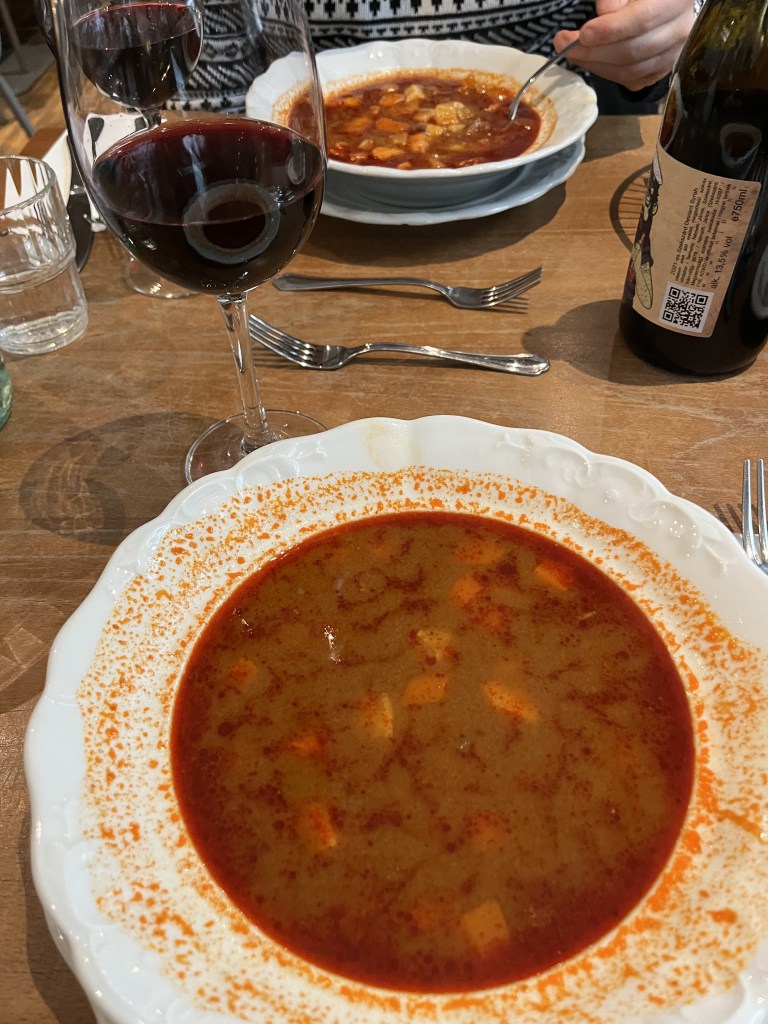
As we expected, the food and wine was beautiful. We chose a bottle of Syrah because it had the name János after our granddad in it and serendipitously, its spiciness paired very well with our gulyásleves (goulash soup). The goulash was stunning, far, far better than portrayed in the picture. It was a rich velvet red colour bursting with flavour, an ideal winter warmer on a day colder than the one before.
Paprikás Csirke (chicken paprikash) is a family dish for us and we all cook it in our own slightly different way: some using red wine, some using white, differing spiciness levels of paprika, real stock and Oxo cube stock, varying tonalities of redness and textures etc… it always goes down so well with friends! It was imperative to try a paprikash here in Budapest. I opted for chicken and Luke opted for veal; mine came with nokedli (dumpling noodles) and Luke’s came with a sort of circular rösti of fried tagliatelle-style pasta and bacon… gorgeous.


If you are reading this in the UK, there are only about three Hungarian restaurants in Britain, but I wish for everyone to try a paprikash at least once- it’s a sin that it is unknown here!
If you can’t get to Hungary just yet, I highly recommend cooking one from home. You don’t need many ingredients- mainly your choice of meat or vegetarian/protein equivalent, onions, olive oil, stock, paprika (Hungarian only), wine, sour cream to top and flour and water for the dumplings if you wish to make them!
Recipes online vary but this one would be reliable enough if you wish to have a go!
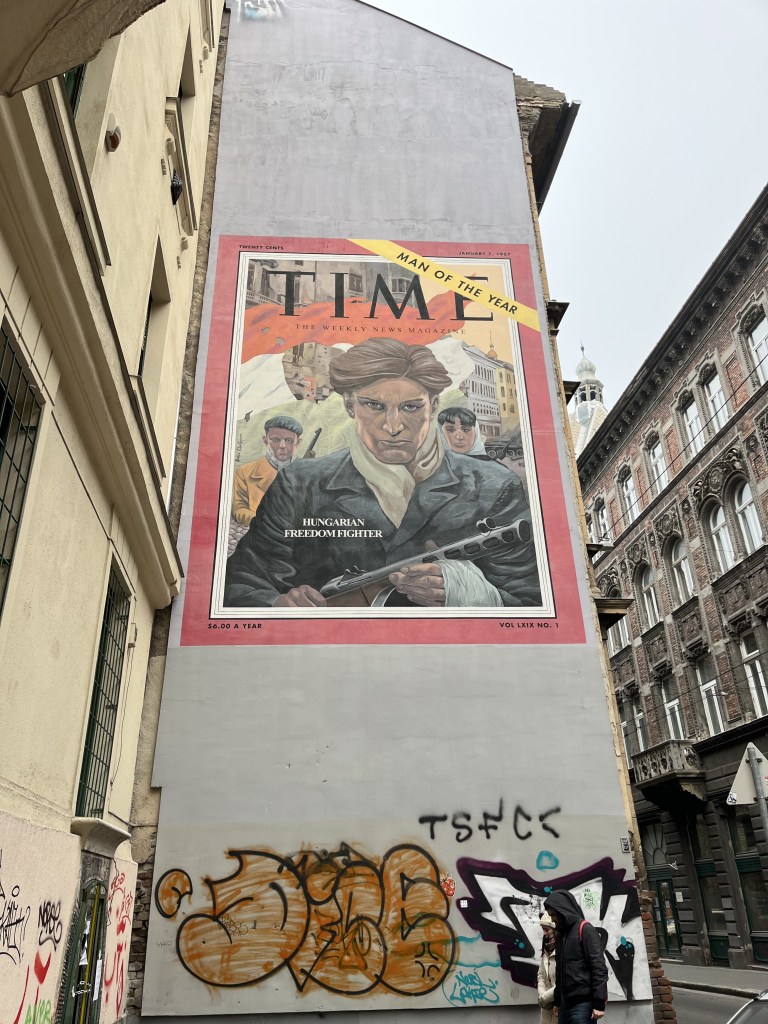
After lunch, we walked over the chain bridge to the Buda side which immediately feels less touristic despite the number of architectural sites there.
It was a grey, misty day so visibility obviously wasn’t great but I was quite pleased with how these two pictures of the Hungarian parliament buildings turned out:


I hadn’t been to the Fisherman’s Bastion in my previous two trips to Budapest so I did really want to visit. On a clear day, the views would be stunning. We couldn’t see much from the top but the architecture itself is beautiful.
Building began in 1895 with the intention to serve as both a watch tower and a fairytale-esque viewing platforms for Hungarians to enjoy views of their city.

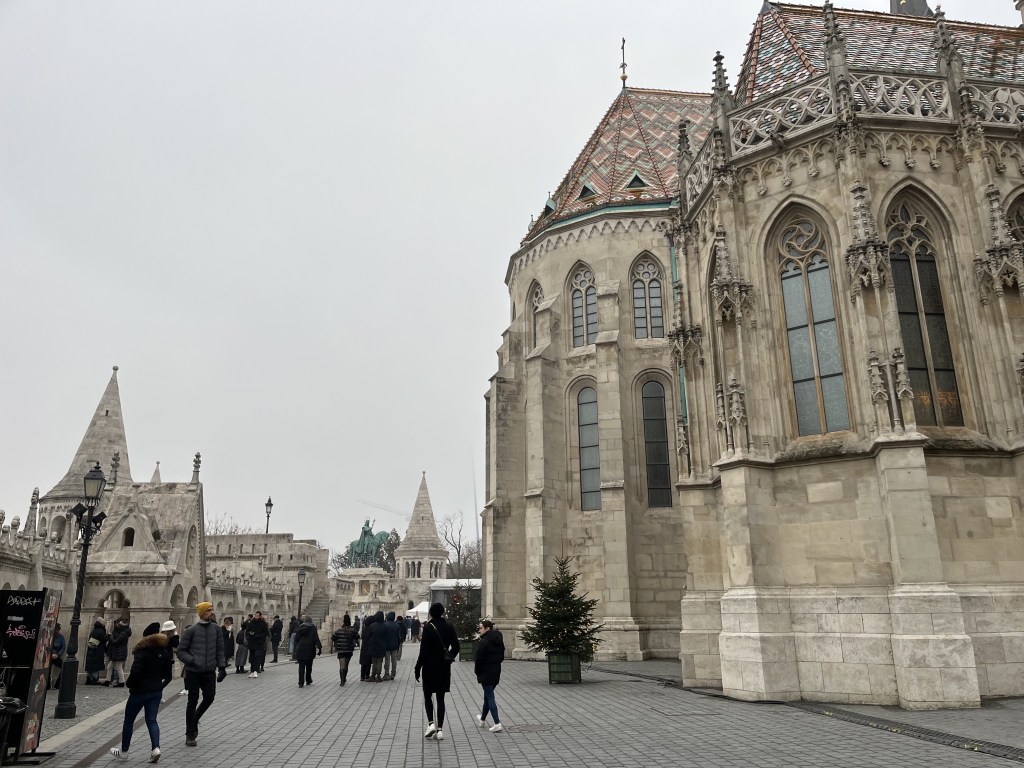

Ascending Castle Hill, it was admittedly starting to get quite cold. I was wearing tights and ankle boots and was wishing I had put a pair of socks on over my tights. This was the only time when it did feel notably cold though, most of the time it was mild and nothing to put one off from visiting at Christmas.
Darkness begins to draw in around 4pm just as it does in the north of England so we headed back over the chain bridge to Pest.
Cutting through one of the main squares, Vörösmarty tér, I suddenly saw a café that took me right back to 2007, when I was 19: The Gerbeaud Café. It’s funny how 17 years can feel like a lifetime ago and only a handful of years ago all at once when you are back in the same surroundings, evoking the memory into the now. I remember ordering an apple cake and using the Hungarian word alma and feeling brave as most words are so much more difficult!
I ordered a meringue that contained a feather-light apricot filling and was dusted in gold glitter and decorated with beads of rosemary gel. Heaven.
Luke ordered the traditional Hungarian Dobos cake which is multi-layered with chocolate buttercream and caramel.
We both chose a sparkling brut wine to cut through the sweetness, in the form of Tokaji, Hungary’s famous white wine from the north-eastern wine producing region of the same name.

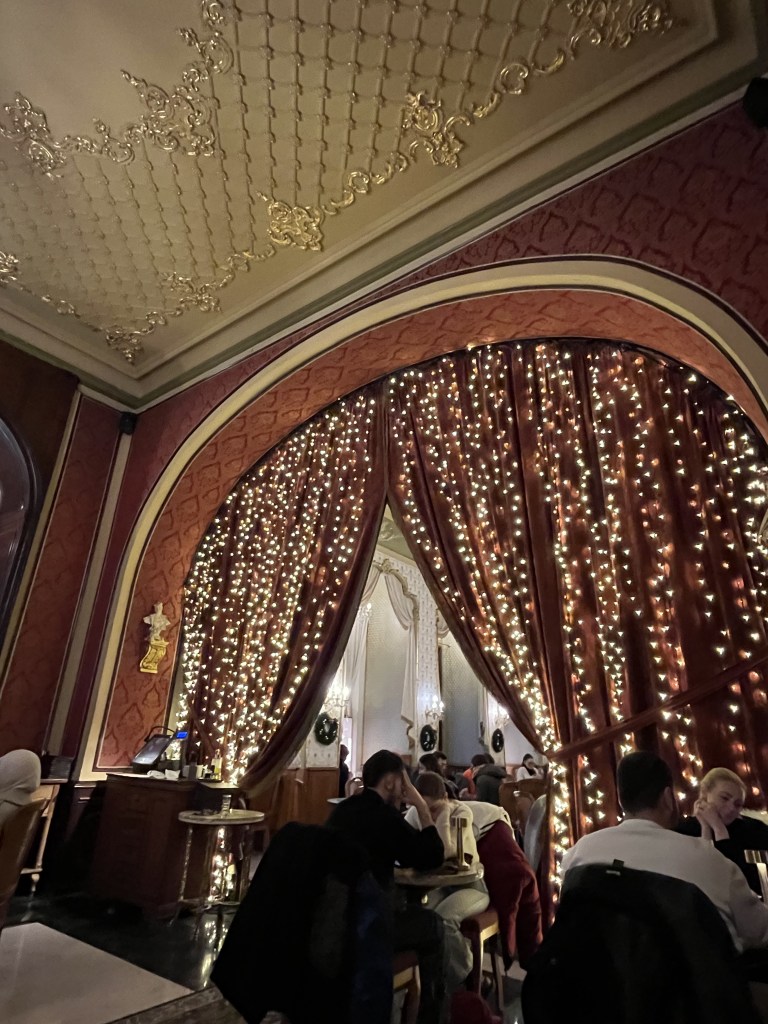
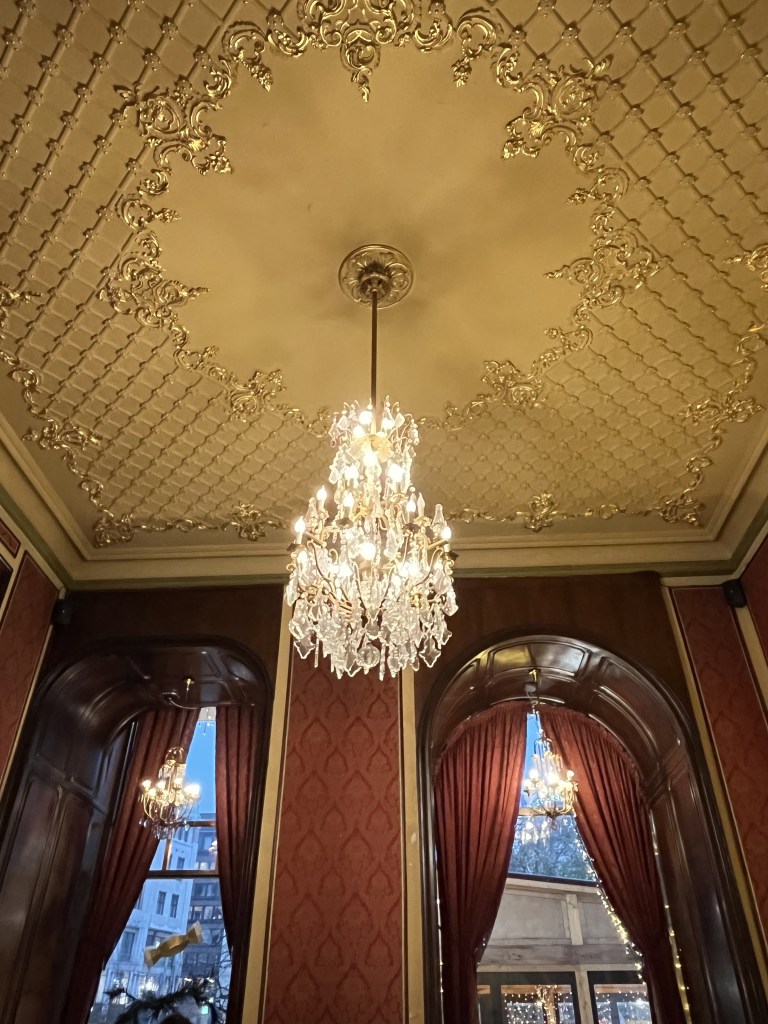



After a return to the hotel for a rest, we jumped in a Bolt taxi and headed to the Tompa Street area which can be thought of as a trendy, gentrified downtown district of Budapest.
As if we hadn’t lavished our epicurean senses in delectable food and wine enough for the day by this point, we had booked on to a private Hungarian wine tasting at a bar called Wine The Gap, delivered by the extremely knowledgeable wine journalist and judge Miklós Csizmadia.
Miklós is passionate about all things Hungarian wine (bor) and dedicated a lot of time to us, talking us through a wine map of Hungary and distinguishing between the red, white and rosé regions of the country and enlightening us on why Hungarian wines are not so famous in other countries despite being of amazing taste and quality (hint: they drink most of their own!).
Miklós is a great story teller with impressive fluency in English who wove fascinating narratives around every glass. He gave us around 6 tastings and talked in detail about every one and prepared a gorgeous plate each of Hungarian meats and cheeses to accompany our wines.
The sequencing of the tastings was so clever, starting with a standard table white (fehér– our mothers’ maiden name) and working through to a naturally sweet Tokaji.
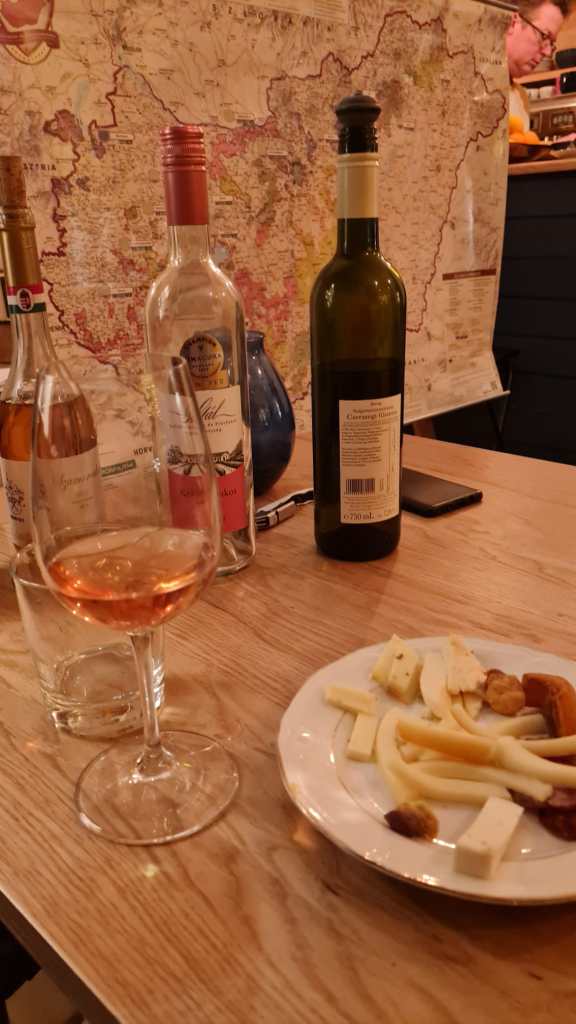

As the evening drew to a close, Miklós had one more surprise in store for us as we are of Hungarian heritage: a tasting of a naturally sweet Tokaji from 2002.
I cast my mind back to that year as I sipped what tasted like liquid gold: I was in Year 9, it was a long, hot summer, Blue were in the charts, Kate Lawler won Big Brother 3, Pop Idol gripped the nation as Gareth Gates and Will Young competed for the top spot… that is something that fascinates me about wine, the time travel. What a privilege.
The Hungarian word for “cheers!” is Egészségedre which looks a minefield to pronounce but is something like ‘egg-ay-sheg-ay-dre’; five syllables long. Practice makes perfect. We certainly practised a lot and said it many times across our evening with Miklós!
Wine The Gap also specialises in stocking Kosher wines which I had only tried once before on my last day working at King David, a Jewish school in Liverpool. We didn’t get round to trying any on this evening but it is so interesting and never surprises to see the breadth of wines out there and it can be rare and expensive to acquire Kosher wines in the UK.
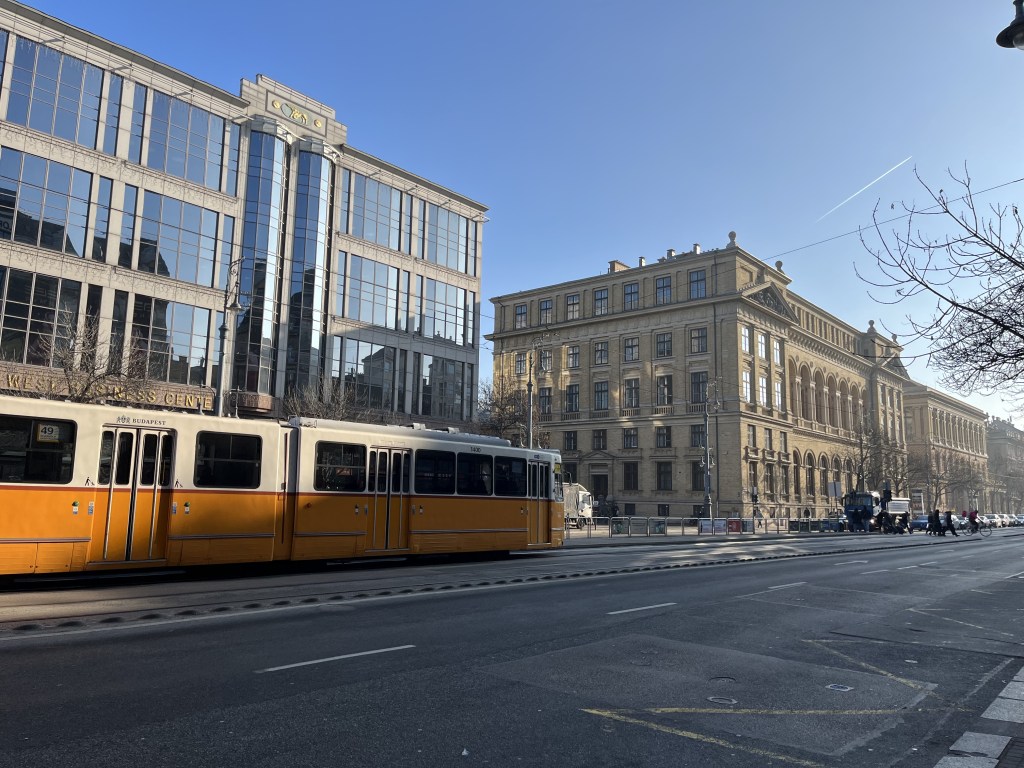
The next morning brought clear, blue skies and a mild temperature. This was going to be a special and significant day for us as we were going to Csepel Island to find the childhood home of our grandad and scatter a small portion of his ashes to return a part of him to where he grew up.
A 25-minute Bolt taxi ride took us out of the city centre and over to Csepel Sziget. The skies reverted to misty and grey at first and it was colder than Pest but we stopped off for lunch before embarking on the search for his house.

Luke had looked up the closest restaurant to our Grandad’s address which was Nádfedeles Csárda (which translates as Sunroof Barn- cute) on Hollandi út. We entered with some trepidation due to language barriers and the very low likelihood there would be any tourists in such a traditional tavern in the countryside.
We were in luck! An amiable lady greeted us at the door and once we stated that we were angolul (English), she told us she speaks English and showed us to a cute red-and-white-checked beclothed table with little wooden chairs with hearts cut out of the backs like something from Goldilocks and the Three Bears.
Around us, local Hungarian families nursed petite glasses of wine and talked softly over low music from the radio.
We felt out of place and at home all at once, such is the familiarity of several dishes, ingredients, scents, words, names and more to us but also grappling with the impenetrable language on the menus: (massive respect to anyone who learns and becomes fluent in Hungarian! I tried when I was 19 and bought a dictionary that my dog George chewed; I believe it is what lead me later to learning Spanish and Italian).
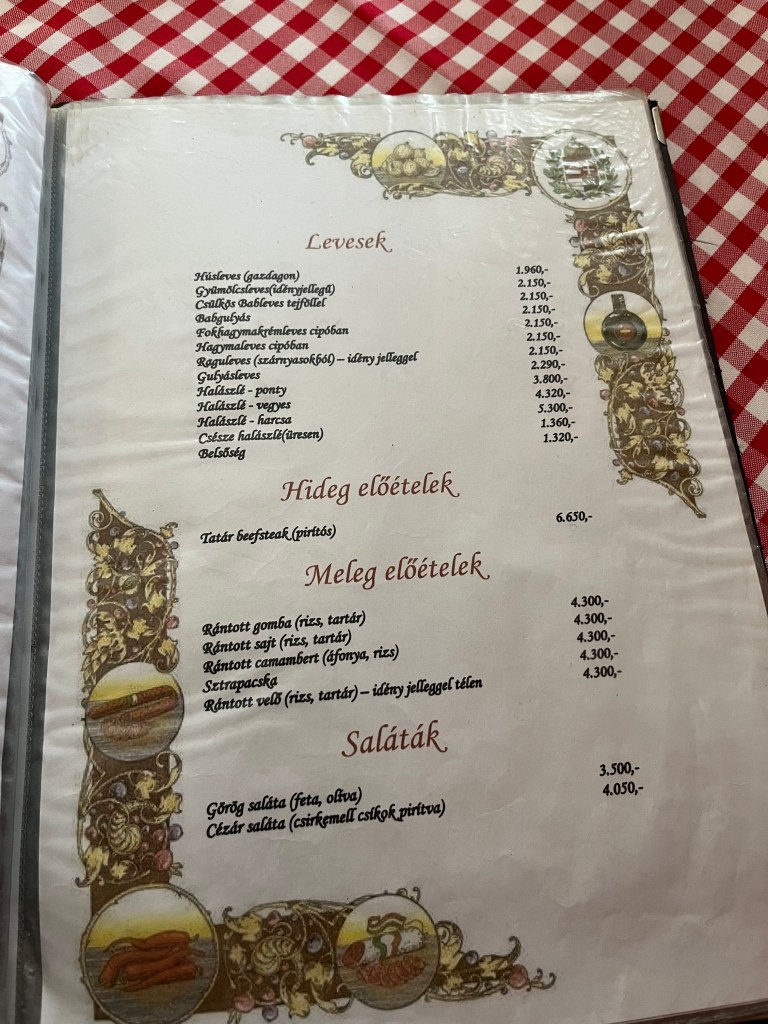
Armed with the Google Translate app, we scanned our cameras over the menu to try to decipher what was on offer. Hungarian does not always translate reliably into English via simple translators (which was a big stumbling block for me when I was trying to obtain dual citizenship with Hungarian to remain European after the Brexit referendum, something I might return to actually..) as proven by one dish translating on Google to ‘strap-on’. Yeah…
I stuck to what felt safe which is unlike me, but I did not wish to offend the hospitable owners.
Luke and I ordered gulyásleves again and it was quite different to the modernised version we had at Gettó Gulyás the day before so didn’t feel repetitive at all.
The picture below will look simplistic but I cannot put into words how gorgeous this was despite appearances:


A touch of blended paprika paste stirred into the goulash was perfect, and we laughed at the entire load they brought us and almost felt rude for only having two slices each.
Little did we know the portion sizes about to come!
Knowing my bird-like capacity for meal sizes, I played it safe and ordered an appetiser which was fried camembert (ironically, the lightest option on the menu!).
I felt intimidated when it came out: five large pieces of deep fried cheese accompanied by cranberry sauce and a superfluous mound of rice all topped with a slice of orange.
I only managed two of those pieces of cheese and a 1/4 of the rice. Luke’s dish was of similar largesse. These are portions for farmers who have been out toiling in fields in bone-chillingly cold conditions all day long needing to stock up on the calories, not two tourists who jump in taxis and go for lie downs after excursions.
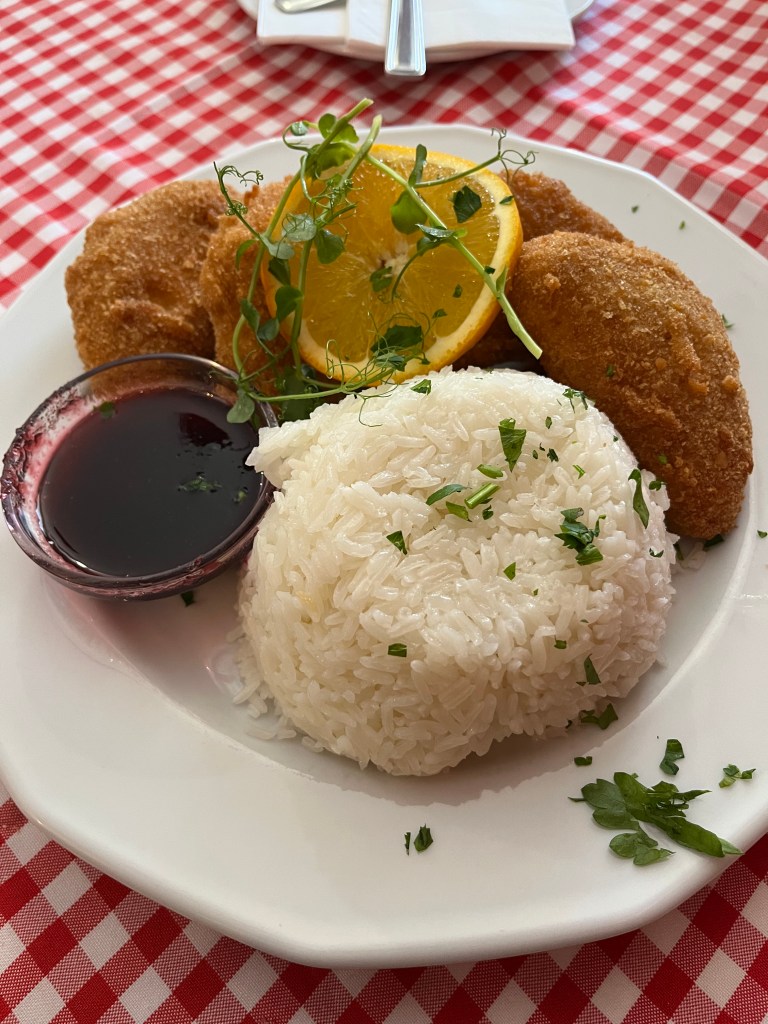
Feeling full, I suggested we order a palinka as a digestivo, similar to how the Italians do with limoncello. This one was much more palatable than the one in the ruin bar, still strong, but not frighteningly so. It may be the placebo effect but it seemed to work in helping us to feel less full.
We paid up and bid the two lovely women who had served us a grateful köszönöm and szervusz (thank you/ goodbye) then set off on the long walk down the avenue towards our grandad’s house.
Our uncle Feri grew up in Budapest at his dad’s childhood home until he was 17 before following him over to England. He told us the address which was on Királyerdó ut, a very long country road with houses only on one side and allotments and vines on the other.

We walked up the avenue for approximately 25 minutes with not a soul in sight, only dogs. Plenty of guard dogs. Several came flying out of their kennels, jumping against metal railings warding off potential intruders. We jumped back a bit a few times but paced on until we eventually reached his house.

This was a surreal moment and meant so much as most people know where their grandad grew up, even if in another country, as communication may have been stronger and more lucid.
For various reasons, too long and convoluted to explain, a lot of information wasn’t clear to us growing up and so it and he has always been enshrouded in mystery which has only added to the hunger to discover more. It is equally fascinating and frustrating at once.
But here we were, stood outside the house where our grandad János grew up with our great-grandmother Katalin and her second husband, where our uncle Feri was also raised.

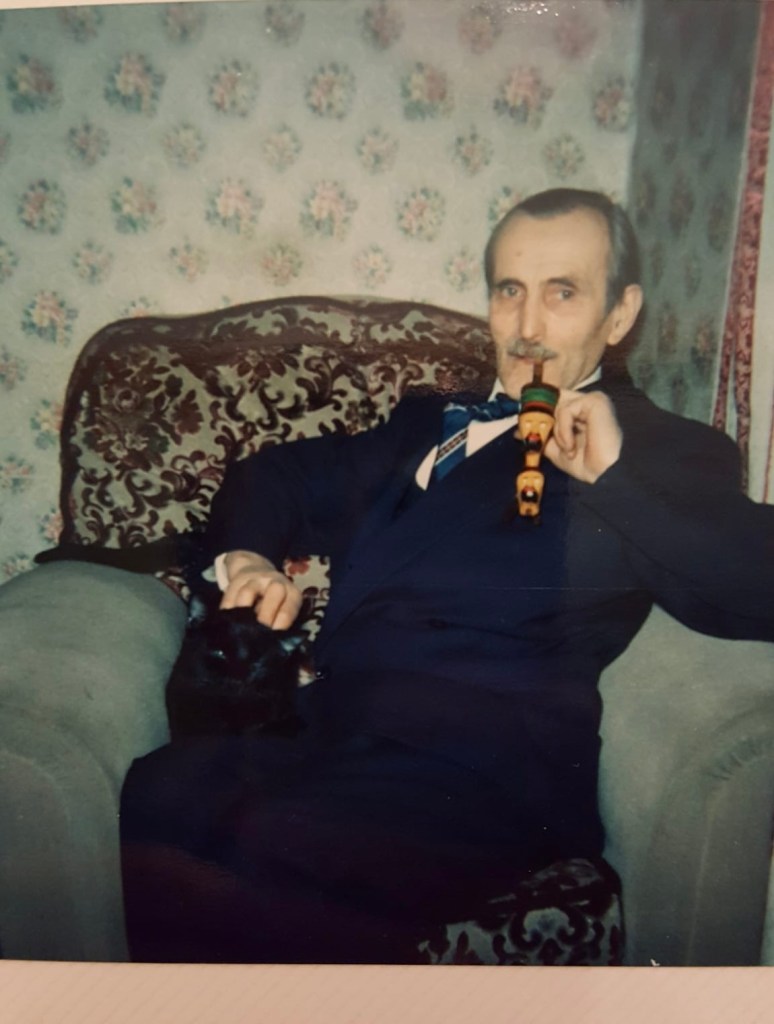



We crossed over to the allotment space over the road from his house and scattered some of his ashes into the soft December winds where he would be carried across vineyards and the streets where he would have played as a child and where he had his first sons before moving to England with his brother following fighting in a Revolution.
It was a poignant moment and we know it meant a lot to our mothers.

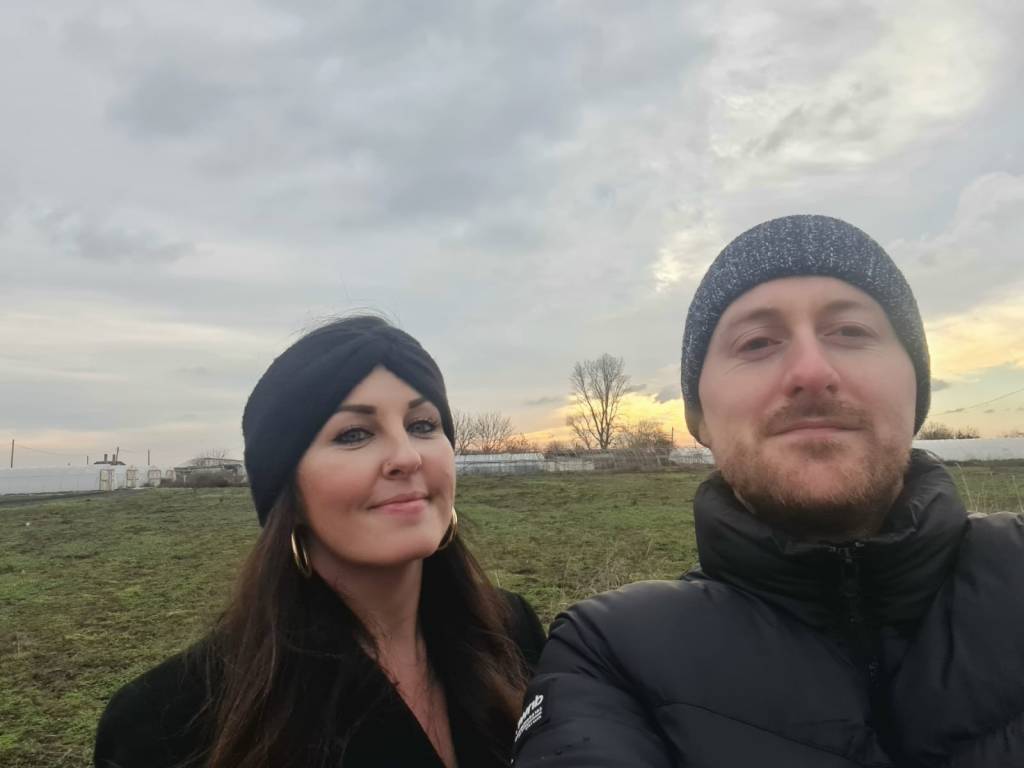
We had booked into another intriguing restaurant in District VII for that evening, called Esca.
Esca is a small, trendy fine dining spot and enoteca with space for only 16 guests serving only natural wines and a menu that presents a modern, gourmet twist on Hungarian and other European cuisine. You can opt for the tasting menu where all dishes are a surprise or order your own small plates.
Being the cautious eater I am, we went for the small plates including oysters, whipped feta topped with chilli flakes, green pesto burrata, and the freshest raw salmon I have ever tasted.
I couldn’t name the natural wines we had but we put full faith in the waiter who paired each one perfectly with the food we had ordered. This sort of dining experience would have cost a fortune back in the UK but cost us around 60 euros/ 23,000 forints each.
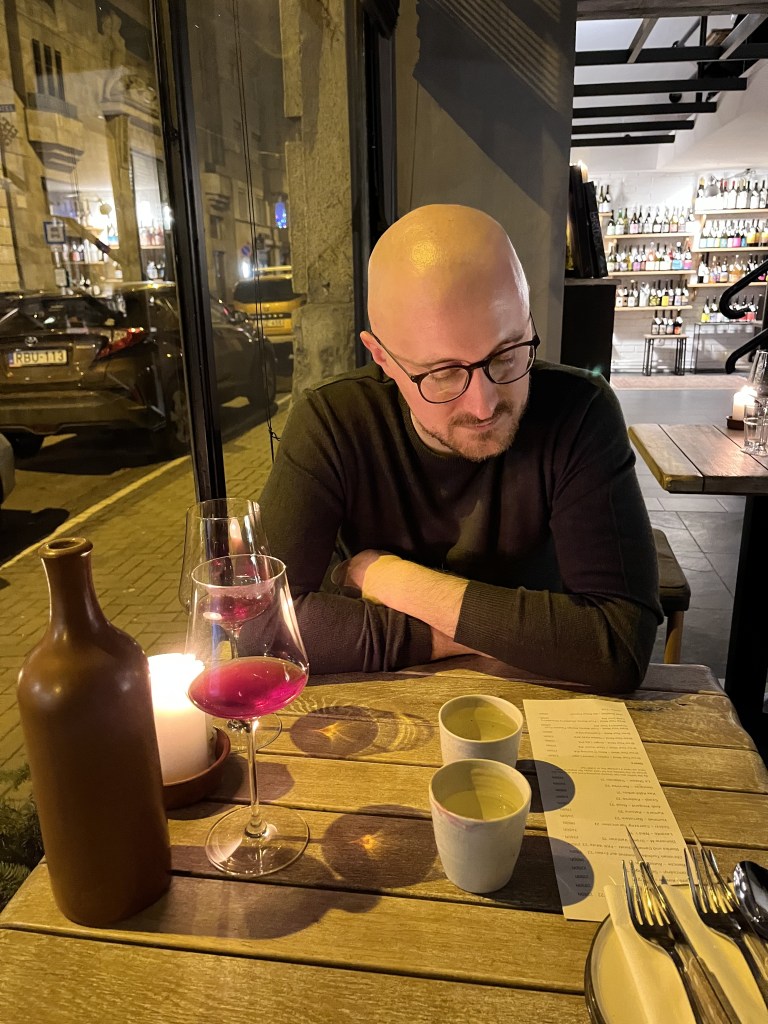
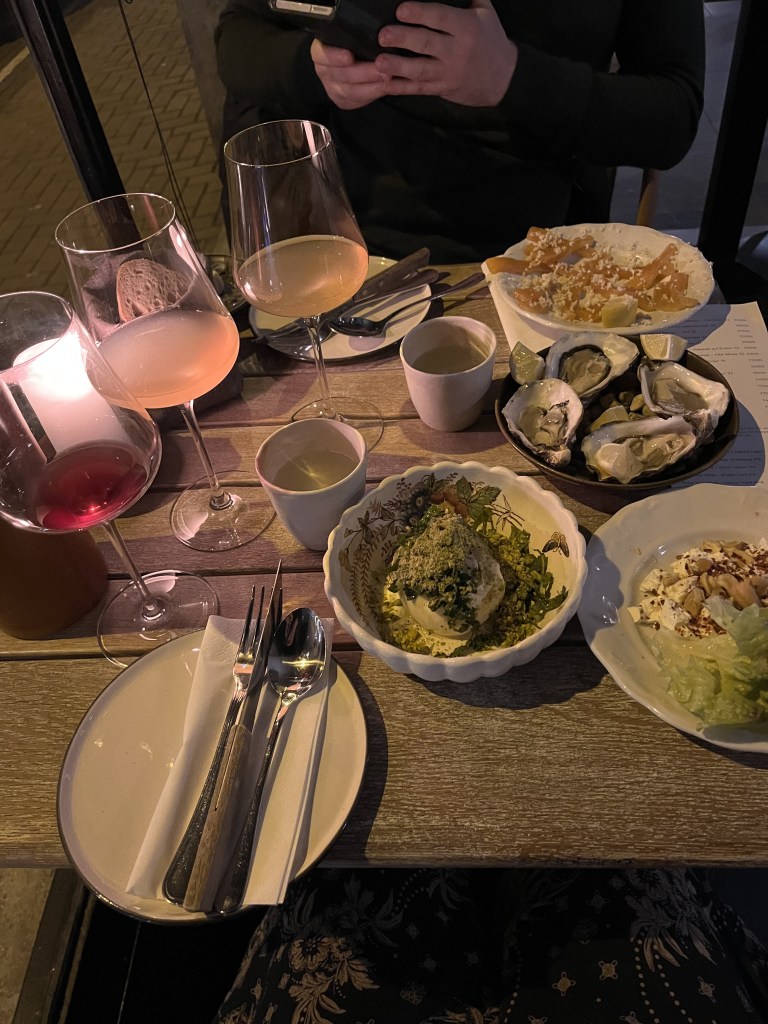
Afterwards, we made a point of going into the McDonald’s next door to our hotel as we always do when abroad to see what menu variations are on offer and we both ended up crying laughing at burgers called the ‘Pork McFarm’, ‘BBQ Bob’, and wraps called the ‘Camembert Claire’, the ‘Vanessa’ and the ‘Rebecca’.
Our last morning dawned and we made our way over to the famous New York Café on one of Budapest’s main boulevards, Erzsébet körút. We thought we may have dodged the queues with it being early on a chilly morning out of peak season but when it boasts the accolade of ‘world’s most beautiful café’, of course there was a wait. We weren’t sure whether it was worth waiting or how long it would take but 15 minutes later, we were in.

I’d waited that long for a much less grander coffee house in Vienna earlier this year and seeing as though I had followed the New York Café on Instagram for around five years, it seemed worth the wait.
Upon entering, it is breathtaking. High ceilings with decor in Italian renaissance style make you feel like you have arrived to have coffee at the Sistine Chapel or the Palace of Versailles. It is truly stunning, all decked out in duck egg blue and gold. There was a violinist and pianist playing gentle music at the back of the café which carried across the ambient sounds of cutlery clinking on plates and dinky crystal glasses chinking in cheers.
The café is around 125 years old, having been opened by the New York Insurance Company as the Viennese coffee house culture had travelled along the Danube and become massively popular in Budapest. Coffee (kávé) was brought to Hungary by the Ottomans in the 16th century and was a beloved drink of our grandad’s throughout his life.

Prices aren’t cheap here but it is fine to stop by for a coffee and a pastry. Luke and I ordered a cappuccino; he opted for apple cake and I for chocolate and cottage cheese pancakes. They were both delightful and worth the money although the price mark-up will definitely be largely down to the exclusive venue and the high demand- they welcome to 2000 customers on busy days!

The only thing is, and it depends on your own views and preferences how you’ll feel about this, but the constant congestion of influencers clamouring for their photoshoot in every nook and cranny is somewhat annoying… it is totally fine and lovely to want to get a great photo in a stunning location, a memento of being young and gorgeous, something to post online, but there is something soulless about the vanity and materialism of people highly stylised in Insta-friendly makeup and clothes who are there just to capture the coveted picture for the ‘gram and not being present and appreciating where they are and what they are eating/drinking.
We saw one couple enter, order afternoon tea, get some photos taken by a balcony, then leave before the afternoon tea was served. The waiter brought it up to an empty table; a crying waste.
There is (IMO) a disingenuousness and lack of self-awareness of people showing up to places for the pic only which conveys to people online that they had an amazing time but really just went for the photo ands didn’t take any of it in. I don’t know… maybe I’m old fashioned. I love pictures and getting dressed up too but there is so much more enjoyment in life in being present.
It’s also selfish to monopolise a view for an elongated ‘photoshoot’ replete with pouting and ring lights when others just want a quick snap of the venue; I bustled in while one man paused to survey his friend’s shots of him to take a one second snap as I wasn’t waiting in a queue of fellow time consuming influencers.

I do get though that the New York Café generates a vast amount of its business from marketing itself as a highly ‘Instagrammable’ place and people do love getting those pictures… live and let live… to a degree. It’s just symptomatic of the world we live in now, I suppose. There is nothing wrong in and of it in itself but seeing people seemingly not enjoying where they are to clamour for the pic that will get them more likes than the next influencer is a bit of a shame (again, IMO).
Our final pitstop before heading to the airport was the Budapest Great Market Hall. For some reason, I was expecting it to be like the food halls in Madrid where its primary function is to wine and dine but it was a classic food market where locals go to buy fish, meat, fruit, vegetables, paprika and textiles while tourists can pick up their fridge magnets (always a must) and souvenirs.


Luke and I stocked up on paprika and gulyás krém and got the gifts in with our remaining forints. I bought my mum a beautiful white table runner hand-embroidered with light blue flowers as embroidery is emblematic of Hungarian folk art and traditions.

We then caught a Bolt to the airport and flew back into a stormy Liverpool with just a couple of days spare to re-energise before Christmas feeling very glad of what we had seen and done but also carrying a strong wish to return next year with more of the family, perhaps teamed with a few days in Lake Balaton.
Before I sign off, I’d like to leave you with a few useful words in Hungarian. I only know a few more familial words than what is listed here; it is a one of the hardest languages in the world to learn but it does pay off to learn a few common words despite the increasing number of English speakers since I last visited in 2008:
| English | Hungarian |
| Hello/bye (informal) | Szia! (see-ya) |
| Please | Kérem (kay-rem) |
| Thank you | Köszönöm (curse-uh-nuhm) |
| Yes | Igen (ee-gen) |
| No | Nem |
| Coffee | Kávé (car-vay) |
| Red wine | Vörösbor (vorosh-bor) |
| White wine | Fehérbor (fe-here-bor) |
| Water | Víz (veez) |
| Restaurant | Étterem (ay-ter-em) |
| Cheers! | Egészségedre! (egg-ay-sheg-ay-dre) |
| Stew | Pörkölt (per-kerlt) |
| Soup | Leves (lev-esh) |
| Beer | Sör (sher) |
| Chicken | Csirke (cheer-keh) |
| Beef | Marhahús (mar-ha-hoosh) |
| Vegetarian | Vegetáriánus (ve-geh-tah-ri-ah-noosh) |
So as we bid a búcsú to Budapest for now, we know it will only be a matter of time before we will be back, keeping alive these traditions in our family, delving through complex language and information that has been held for far too long behind barriers and mystery.


Pingback: Travelling via Wine: Some Memorable Wines from over the Years – Laur On Tour